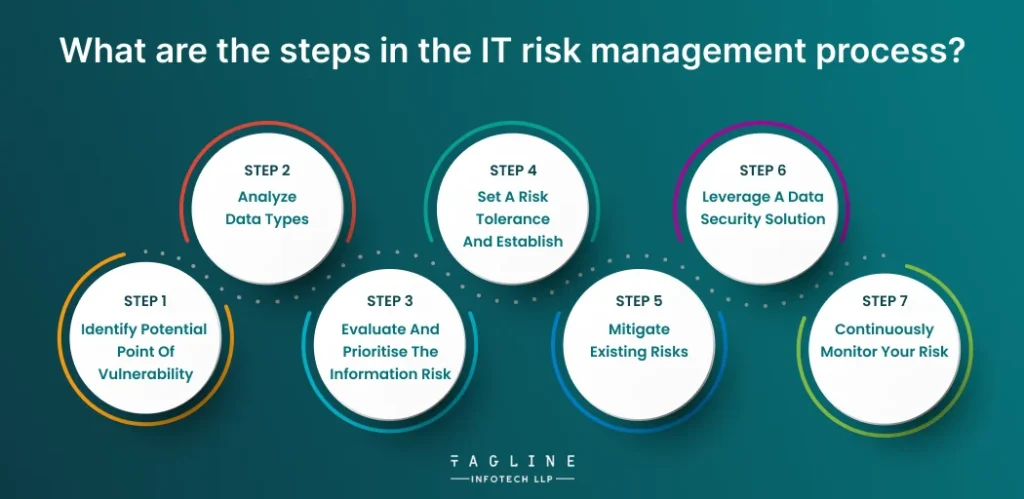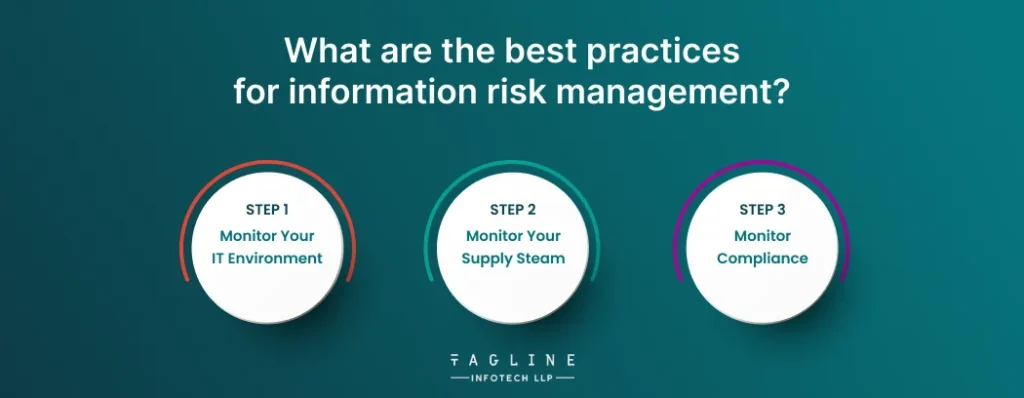Role of Python Libraries in Image Processing
October 30, 2025
Home >> Other >> What is IT Risk Management? The Complete Guide

Information risk management is the process of determining how a disruptive occurrence can affect a company and how to minimise the harm.
Any situation in which the confidentiality, integrity, or accessibility of data is jeopardised is included.
As a result, you should be concerned about more than simply cyberattacks. Information risk management also takes into account residual hazards and threats that may come from within your company, such as careless or malevolent staff.
The framework, for instance, can assist you in addressing improperly configured databases, software flaws, and subpar third-party security procedures.
IT risk is the likelihood that an information system vulnerability may be used by a specific threat or malicious actor to cause an unanticipated, unfavourable business impact.
It may include everything from equipment breakdown and human mistake to cyberattacks and natural calamities.
The use of risk management techniques to control IT dangers is known as IRM. In order to identify and evaluate possible risks and vulnerabilities in IT infrastructure, risk management IT methods, policies, and technologies are used.
GRC, or Governance, Risk, and Compliance, plays a pivotal role in risk management, encompassing much more than mere framework selection or occasional risk assessments.
It entails the integration of practical risk management strategies, process implementation, and measuring their effectiveness.
GRC also considers how organizations identify and address risks while complying with legal obligations, including those related to finance, technology, human resources, industry-specific risks, and regulatory standards.
In one instance, a retired British police officer transitioned into a GRC role, emphasizing the importance of individuals who can identify issues and propose solutions beyond adhering to rule lists.
While a common five-step risk management process helps ensure compliance, the approach to business risk management may differ significantly from that of IRM, particularly in the realm of cybersecurity. Common root causes of risk management IT issues often require a deeper exploration.
The identification, evaluation, and mitigation of possible risks that might have an influence on an organization’s operations, financial stability, and reputation are key components of any successful business plan.
Businesses often follow a defined procedure when tackling risk management to handle frequent risk concerns, including those you’ve mentioned:
Security encompasses more than simply internal and external dangers. It also includes the procedures and individuals employed in the development of technical solutions. Instead of making sure the procedures are shielding the organisation from risk, security personnel are frequently charged with incident mitigation.
Technical debt is what happens when a person or organisation intentionally (or even unknowingly) chooses to omit certain processes or employ an outdated set of resources out of necessity when developing a gadget or piece of software.
Technical debt in IT risk management may take many different forms, including ignoring crucial risk management procedures, tasks, and testing. Teams frequently adopt technical debt practises as a result of time or budget restrictions.
Then, IT teams believe that by skipping stages in the future, the debt will be paid off.
One of the most frequent risk management problems is a lack of communication between IT and leadership. Process maturity is a requirement for effective risk management, which can only be achieved when organisational leaders effectively communicate risk.
Consider a C-level security executive at a significant American store. He discovered that communication there was adequate but not great. He believed that he couldn’t discuss procedures and necessary adjustments as freely as he would have liked.
He then switched to handling security for a retail firm from a computer company. He chose that new position mostly because he recognised the opportunity for effective collaboration with his coworkers.
Data breaches are lessened by an IRM programme, might result in significant cost savings. In 2020, the average cost of a data breach was $3.86 million worldwide.
An IRM plan includes the following advantages in addition to cost savings:
It makes achieving company goals and maintaining business continuity easier.
Ready to bring your software idea without the worries of IT risk management?
Hire our skilled developers to get started on your software development project and turn your vision into reality

Identifying the location of information, analysing the type of information, prioritising risk, establishing a risk tolerance for each data asset, and continuously monitoring the enterprise’s IT network are crucial steps that organisations implementing an IRM programme need to take.
These 7 stages may be further broken down to demonstrate their applicability for a successful IRM programme.
Finding the places where your data is stored sounds straightforward enough conceptually. Most businesses start with their databases or teamwork software. But as more businesses choose cloud-first or cloud-only strategies, data becomes increasingly scattered and exposed to online dangers.
Data is no longer exclusively kept on-site by organisations. Nowadays, many people utilise shared drives or other cloud-based storage options like serverless.
Additionally, a lot of organisations now use innovative methods to collect data, such customer-facing online portals.
The way that businesses exchange information with internal and external stakeholders has also changed as a result of new data transmission channels like email and messaging services.
You must be aware of both the location of your data and the type of data you are collecting. Data types are not all created equal.
Information like a person’s name, birth date, social security number, or even IP address is considered personally identifiable information (PII). The information is a high-risk asset since bad actors frequently target PII because they can sell it on the Dark Web.
You also have low-risk material on hand, such marketing text. For example, malevolent actors are unable to sell a duplicate of a blog article online.
After reviewing and categorising all data assets, you must now assess the risk. There is a specific place where each sort of data asset is located.
You must ascertain how each danger interacts with the others and influences the likelihood of an assault by a bad actor. The most effective approach to achieve this is to compute:
Risk Level = X * Probability of a data leak Costs associated with a data leak
A low-risk data asset, like marketing content, could be in a high-risk place, like a file-sharing application. However, if a bad actor obtains the information, the financial impact on your business will be negligible. As a result, this might be considered low or moderate risk.
A risk can be accepted, transferred, mitigated, or refused depending on your risk tolerance. Purchasing cyber risk liability insurance is an example of a control for shifting risk.
Installing a firewall to block access to the site where the data is stored is an example of a control for reducing risk.
Firewalls and encryption are examples of mitigating measures that serve as barriers to harmful actors. Even mitigating controls, nevertheless, may fail.
You should design mitigation strategies for the risks identified as being above the risk tolerance as well as risk management procedures.
These controls include of defence mechanisms including firewalls, data encryption, data backups, maintaining current hardware, and implementing multi-factor authentication measures.
For significant risk scenarios, it is advised to invest in a data security solution to lessen the workload on internal teams.
By limiting access to data to security experts, investing in data security solutions helps reduce the possibility of internal attacks.
Malicious actors are always changing how they pose a danger. Malicious actors have reacted by concentrating more on cryptocurrencies and phishing as businesses become more adept at spotting and defending against new ransomware outbreaks.
In other words, today’s strong restrictions might become vulnerable in the future.
The following IRM best practises can help organisations achieve complete compliance and improved security.

Your organisation can identify flaws and prioritise remedial tasks by closely monitoring its IT environment.
For instance, configuring cloud resources is a challenge for many organisations. “AWS S3” buckets are commonly mentioned in news stories.
These public cloud storage places are not inherently dangerous, but if they are improperly configured, the public, including attackers, can access them.
To improve information security, it is possible to find misconfigured databases and storage sites by continuously monitoring your IT environment.
Your IRM approach must include third-party vendor risk reduction as well. Although you have authority over your vendors, it’s possible that you won’t be able to enforce the same legal requirements upon their vendors.
You require insight into the cybersecurity posture throughout your ecosystem as part of your comprehensive information risk management plan.
Your information is at danger, for instance, if the vendor of your vendor utilises a cloud database and keeps data in plain text.
The cyber health of your ecosystem may be seen by continuously checking your supply stream for encryption, a method of rendering data unintelligible even if an attacker has access to it.
Legislative governments and industry standards groups have issued stricter compliance rules as data breaches garner greater news coverage.
A compliance cybersecurity programme must include ongoing monitoring since it is mandated by a number of new legislation, including the General Data Protection Regulation (GDPR), the California Consumer Privacy Act (CCPA), and the New York Stop Hacks and Improve Electronic Data Security (NY SHIELD Act).
SecurityScorecard’s security ratings platform offers continuous insight into the effectiveness of an organization’s IRM program.
By aggregating publicly available internet data, it assesses ten critical factors, including IP reputation, DNS health, web application security, network security, leaked credentials, hacker discussions, endpoint security, and patching frequency.
Employing a user-friendly A-F grading system, the platform provides a quick, comprehensive view of an organization’s overall cybersecurity posture while delving into individual factors.
These ratings empower organizations to identify strengths and weaknesses, allowing them to prioritize their IRM strategies. Additionally, it supports third-party risk management, aiding in supply chain information risk assessment and vendor communication, ultimately enhancing data security and network resilience.
Effective IT change management is essential in the contemporary digital landscape in which data breaches and cyber threats are general.
It encompasses figuring out vulnerabilities, studying facts kinds, prioritizing dangers, organising danger tolerances, implementing mitigation techniques, and non-prevent monitoring.
Security Scorecard’s safety rankings platform gives useful insights to beautify your danger management efforts and ensure the resilience of your organization’s IT infrastructure.
Risk control is crucial because it lets groups reduce the opportunity of high-priced statistics breaches, enhance cybersecurity resilience, stabilize business operations, decrease felony liabilities, reduce coverage fees, guard employees, and ensure the continuity of enterprise desires.
The steps in the IRM process include figuring out vulnerabilities, analyzing facts kinds, evaluating and prioritizing statistics chance, setting threat tolerances, mitigating cutting-edge risks, leveraging data protection answers, and continuously monitoring the chance to evolve to evolving threats.

Digital Valley, 423, Apple Square, beside Lajamni Chowk, Mota Varachha, Surat, Gujarat 394101
D-401, titanium city center, 100 feet anand nagar road, Ahmedabad-380015
+91 9913 808 2851133 Sampley Ln Leander, Texas, 78641
52 Godalming Avenue, wallington, London - SM6 8NW